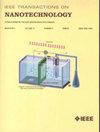Oblique Angle Deposition of Slanted TiO2 Columnar for UV Photodetector Application
IF 2.1
4区 工程技术
Q3 ENGINEERING, ELECTRICAL & ELECTRONIC
引用次数: 0
Abstract
With the advancement of optoelectronic technology, a new evaluation of photodetectors’ (PDs’) performance is necessary for next-generation sensing applications. This study uses the e-beam evaporation approach to produce slanted titanium dioxide columnar (TiO2-COL) on the Si substrate, with a constant deposition angle of ∼ 61°. The morphology, structural, and optical properties of the fabricated TiO2-COL samples were examined. Successful growth of the slanted TiO2-COL structure is demonstrated by field emission scanning electron microscopy (FE-SEM). Furthermore, XRD analyses reveal that TiO2-COL has an amorphous nature. Optical characterization reveals that the fabricated sample exhibits high absorption intensity in the UV region, for demonstrating a potential UV photodetector application. The TiO2-COL based PD that was deposited obliquely displayed I-V curves that demonstrated a distinct photovoltaic mode and an extremely low dark current of a few nanoamperes. Moreover, at ∼ 320 nm, the device exhibits a self-powered UV light response with a responsivity value of around ∼ 1.3 mA/W. In addition, this TiO2-COL based photodetector device demonstrates a remarkable detectivity and noise-equivalent-power (NEP) and rise time/fall time of ∼ 4.63 × 1010 Jones, ∼ 6.06 × 10−11 W and ∼ 0.305/0.184 sec, respectively, at −0.1 V. Therefore, this novel idea of a slanted TiO2-COL structure promotes effective light management and offers a reliable route for creating Low-powered UV PDs.倾斜TiO2柱状物的斜角度沉积在紫外光电探测器中的应用
随着光电技术的进步,对光电探测器(pd)的性能进行新的评估是下一代传感应用的必要条件。本研究使用电子束蒸发方法在Si衬底上产生倾斜的二氧化钛柱状(TiO2-COL),其恒定沉积角为~ 61°。研究了制备的TiO2-COL样品的形貌、结构和光学性能。场发射扫描电镜(FE-SEM)证实了TiO2-COL倾斜结构的成功生长。XRD分析表明,TiO2-COL具有非晶态性质。光学表征表明,制备的样品在紫外区具有高的吸收强度,证明了紫外光电探测器的潜在应用。斜沉积的TiO2-COL基PD显示出明显的光伏模式和极低的几纳米安培暗电流的I-V曲线。此外,在~ 320 nm处,该器件表现出自供电的紫外光响应,响应度值约为~ 1.3 mA/W。此外,这种基于TiO2-COL的光电探测器装置在−0.1 V下表现出显著的探测性和噪声等效功率(NEP)和上升/下降时间分别为~ 4.63 × 1010琼斯,~ 6.06 × 10−11 W和~ 0.305/0.184秒。因此,这种倾斜TiO2-COL结构的新想法促进了有效的光管理,并为制造低功率UV pd提供了可靠的途径。
本文章由计算机程序翻译,如有差异,请以英文原文为准。
求助全文
约1分钟内获得全文
求助全文
来源期刊

IEEE Transactions on Nanotechnology
工程技术-材料科学:综合
CiteScore
4.80
自引率
8.30%
发文量
74
审稿时长
8.3 months
期刊介绍:
The IEEE Transactions on Nanotechnology is devoted to the publication of manuscripts of archival value in the general area of nanotechnology, which is rapidly emerging as one of the fastest growing and most promising new technological developments for the next generation and beyond.
 求助内容:
求助内容: 应助结果提醒方式:
应助结果提醒方式:


